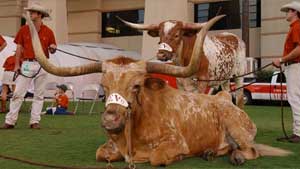 In short, they meet the taxidermist.Â
In short, they meet the taxidermist.Â
The longhorn mascot tradition began in 1916 when a Texas ex named Stephen Pinckney, who picked apart cattle rustling gangs while at the U.S. attorney general’s office, discovered an orange-furred longhorn during a raid in Laredo.
With contributions of $1 from 124 alumni, Pinckney bought the animal and brought it to Austin where it was presented to the student body during halftime of the Texas A&M game.
An online poll of mascots shows Bevo trailing only Keggy the Keg — Dartmouth’s unofficial mascot — as the nation’s best. No. 3 is Handsome Dan, the Yale bulldog, and fourth is the University of California at Santa Cruz’s banana slug.
Bevo I eventually became the barbecued main dish for the January 1920 football banquet. But Brennes assures Bevo XIII “will not be eaten.”
Baker said he will preserve Bevo XIII as a shoulder mount.
What’s worst? Getting stuffed or suffering the fate of the first Bevo, getting fattened up and eatened.
They don’t use the meat for the shoulder mount. They should provide that meat to a local orphanage for consumption.